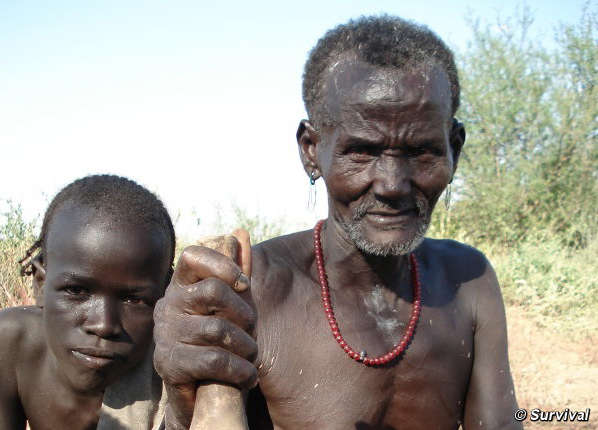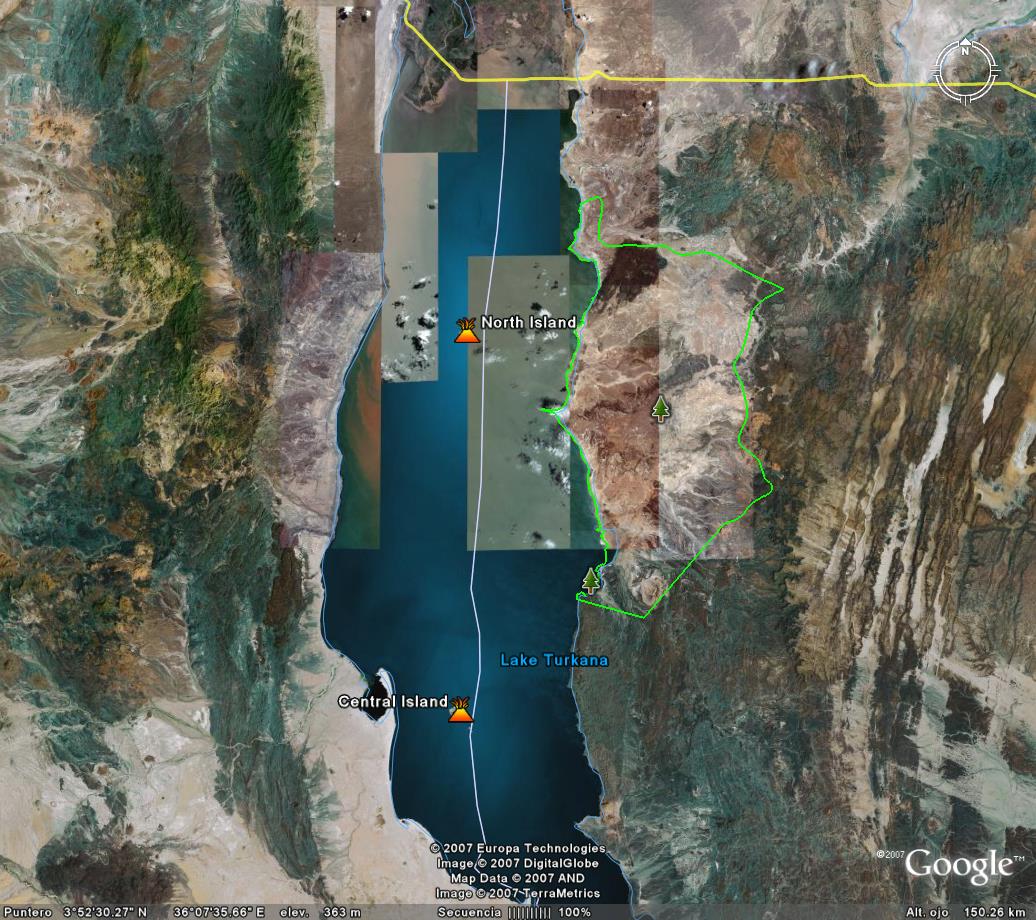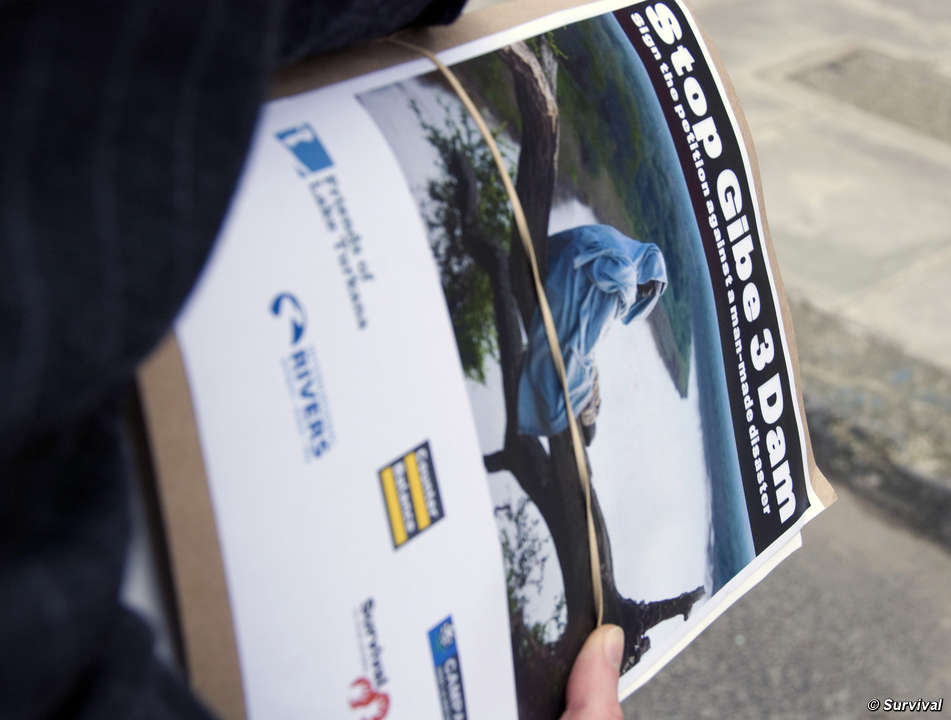Ethiopian embassies across Europe and in the United States received the international petition against the country’s flagship hydroelectric project, the Gibe III dam.
Survival International, International Rivers, la Campaña para la Reforma del Banco Mundial, la Counterbalance Coalition y Amigos del Lago Turkana han unido sus fuerzas para lanzar la recolección de firmas que pide al Gobierno de Etiopía que “suspenda el proyecto de la presa Gibe III en el río Omo hasta que, y sólo en caso de que, consiga el consentimiento previo, libre e informado de los pueblos indígenas afectados por el proyecto”.
Día Mundial del Agua: indignación por la megapresa en Etiopía ...
www.survival.es/noticias/7100 - En caché

Indignación por la megapresa en Etiopía
Unas 400 organizaciones han firmado una petición en contra de la presa más alta de África, que será entregada en las embajadas etíopes de Europa y Estados Unidos con motivo del Día Mundial del Agua, que se celebra el 22 de marzo.
Al menos ocho pueblos indígenas de Etiopía y unas 300.000 personas que viven en los alrededores del famoso lago Turkana en Kenia están amenazados por la presa Gibe III en el río Omo. Se entregarán copias de la petición en Francia, Alemania, Italia, Bélgica, Reino Unido y Estados Unidos.
La presa, que según el Gobierno etíope está ya completada al 40%, destruirá los patrones de inundación naturales que son vitales para los métodos de cultivo de los pueblos indígenas del Omo. Aunque el Gobierno asegura que una “inundación artificial” solucionará el problema, los constructores de la presa revelaron el año pasado sus planes para que las tribus “cambien de la agricultura basada en la retirada de la inundación a formas de agricultura más modernas (sic)”, tras un periodo de transición.
Un “cambio” impuesto de este tipo será, casi con toda seguridad, desastroso, y supondrá el fin de la ya inadecuada “inundación artificial” sin ninguna garantía de que haya otros medios de supervivencia.

Un miembro del pueblo indígena cazador-recolector kwegu declaró: “Dependemos de la pesca, son como nuestro ganado. Si terminan las inundaciones del Omo, moriremos”.
El Gobierno etíope también ha destinado 180.000 hectáreas de tierra en el valle del Omo para inversión agrícola. Parte de esas tierras están en los territorios de los pueblos indígenas nyangatom, karo y mursi.
No se ha consultado a las comunidades indígenas sobre la presa, el “cambio” en su modo de vida o el arrendamiento de sus tierras a inversores extranjeros, algo que viola la propia Constitución de Etiopía.
El Banco Europeo de Inversiones y el Banco Africano de Desarrollo han decidido no financiar la presa. El Industrial and Commercial Bank of China y el Exim Bank of China están financiando partes del proyecto pero Etiopía necesita encontrar más fondos. El Gobierno italiano aún está considerando si financiar la presa o no, mientras que Etiopía se acaba de convertir en el principal receptor de la ayuda británica al desarrollo. Se espera que reciba dos mil millones de dólares en los próximos cuatro años.
Survival International, International Rivers, la Campaña para la Reforma del Banco Mundial, la Counterbalance Coalition y Amigos del Lago Turkana han unido sus fuerzas para lanzar la recogida de firmas. La petición pide al Gobierno de Etiopía que “suspenda el proyecto de la presa Gibe III en el río Omo hasta que y (sólo en caso de que) consiga el consentimiento previo, libre e informado de los pueblos indígenas afectados por el proyecto”.
El director de Survival, Stephen Corry, ha declarado hoy: “Si el Gobierno construye la presa sobre el agua de los pueblos indígenas del Valle del Omo y alquila sus tierras a extranjeros, puede que estos pueblos no sobrevivan. El Gobierno está fomentando la industrialización a costa de las personas más vulnerables del país”.
FIN
Algunos bancos y empresas involucradas:
Salini Costruttori (Italia) – principales constructores de la presa
Harsco (EEUU) – proveedores de materiales
Dongfang Electric Corporation (China) – trabajos electro e hidromecánicos
ICBC (banco chino)
EXIM (banco chino)
----------------------------------------------------------------------------------------------------------------------------
Archive for March, 2011
Wednesday, March 23rd, 2011 Ethiopian embassies across Europe and in the United States received the international petition against the country’s flagship hydroelectric project, the Gibe III dam, yesterday.
At 243 metres Gibe III is to be Africa’s tallest dam, and it has already earned a place as one of the most controversial. Survival joined forces with International Rivers, the Campaign for the Reform of the World Bank, the Counter Balance Coalition and Friends of Lake Turkana to launch the petition last year. Yesterday, we delivered it.
Support has come from around the world, including from concerned Kenyan herders whose thumb prints adorn pages upon pages amongst the signatures delivered today. Almost 400 organizations have also endorsed the petition.
.
.
The dam is being built on the Omo River, which courses through the famous Omo Valley and feeds into Lake Turkana over the border in Kenya. The river cuts a rich and fertile seam into an arid, unforgiving landscape. For the people living along its banks the Omo is a vital source of life.
If you need another clue about how disastrous Gibe III would be, take note that the European Investment Bank and the African Development Bank – both institutions with a keen interest in supporting Africa’s energy sector – have each decided not to fund the dam.
Nonetheless Ethiopia’s President, Meles Zenawi, has told reporters that Gibe III will be completed ‘whether you like it or not.’ So, just in case he’s reading, here are five key reasons why Africa’s tallest dam would be a monumental disaster for some of the region’s most vulnerable people.
1) Broken laws and broken promises
Ethiopia’s constitution promises the Omo Valley tribes the right to be consulted about any state project likely to affect them. Even today, over four years after work on the dam began (well before environmental clearance was granted), they have still not been properly consulted.
In 2009 the government effectively made it impossible for them to organize or share information about the dam, by shutting down 41 community groups. They have been offered no choice, no alternative, and no hope of a better future.
2) An end to the flood
Gibe III will cut off the Omo’s annual flood. Usually, as the flood waters slowly recede a layer of extremely fertile silt is deposited along the river banks. It is this rich silt that allows the Omo tribes to grow their crops there.
The dam builders have said they will create an ‘artificial flood’ for ten days every year. But such a rapid flood will not allow for the vital silt to settle. It will also mean that the Omo tribes will be at the mercy of the dam operators, whose commercial interests might trump the tribes’ needs for water.
3) Lake Turkana
Lake Turkana is a UNESCO world heritage site (so is the Omo Valley). Hundreds of thousands of people have made their home around the lake, fishing its waters and grazing their cattle along its banks. Many believe the already shrinking lake will be severely compromised if Gibe III is completed, as the Omo is the lake’s primary source.
4) Riches to the Rich
Gibe III will generate huge amounts of electricity. Some will be delivered to Addis Ababa and surrounds, but most is destined for Kenya and elsewhere. So the dam benefits will be delivered to those already in positions of power, while the costs – in food security, in livelihoods – will be imposed on those least able to speak out.
5) Ushering in a land grab
In January President Zenawi announced plans for a mega-irrigation project in the Omo Valley. Details are hard to come by but it seems likely that Gibe III is a vital part of that scheme. 180,000 hectares of land, including some tribes’ territories, have already been earmarked for lease to agricultural investors for cash crops including biofuels – depriving the tribes of vital agricultural and grazing land.
March 2011 - Survival International - The movement for tribal peoples -23 Mar 2011 ... At 243 metres Gibe III is to be Africa's tallest dam, ... You are currently browsing the Survival's Blog weblog archives for March, 2011. ...
www.blog.survivalinternational.org/2011/03/ - En caché

 lago turkana o rudolf_africa.kmz
lago turkana o rudolf_africa.kmz

http://lacomunidad.elpais.com/blogfiles/trekkingyaventura/ETNIASYMERCADOS17.JPG








/http%3A%2F%2Fwww.contrainjerencia.com%2Fwp-content%2Fuploads%2F2014%2F07%2Ftimthumb.php_1.jpg)
/http%3A%2F%2Fwww.radio36.com.uy%2Fentrevistas%2F2014%2F08%2F01%2Fclip_image002_0546.jpg)
/http%3A%2F%2Fwww.radio36.com.uy%2Fentrevistas%2F2014%2F08%2F01%2Fclip_image002_0545.jpg)
/http%3A%2F%2Fimg.youtube.com%2Fvi%2FIq04dnHwpYc%2F0.jpg)
